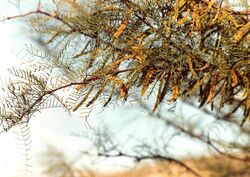Biology:Prosopis chilensis
| Prosopis chilensis | |
|---|---|

| |
| Scientific classification | |
| Kingdom: | Plantae |
| Clade: | Tracheophytes |
| Clade: | Angiosperms |
| Clade: | Eudicots |
| Clade: | Rosids |
| Order: | Fabales |
| Family: | Fabaceae |
| Subfamily: | Caesalpinioideae |
| Clade: | Mimosoid clade |
| Genus: | Prosopis |
| Species: | P. chilensis
|
| Binomial name | |
| Prosopis chilensis (Mol.) Stunz.[1]
| |
Prosopis chilensis is a species of tree in the genus Prosopis, belonging to the family Fabaceae. It is found in parts of central Chile , southern Peru, Bolivia, and Andean (northwestern) Argentina .[2] Its common names include Chilean mesquite (algarrobo chileno, in Spanish), cupesí (in eastern Bolivia),[3] and Chilean algarrobo.[4][5] It is used for providing shade, for animal feed and for firewood.
Description
Prosopis chilensis is a medium-sized deciduous tree reaching a height of about 14 m (46 ft). The trunk is stout and gnarled, and can reach a metre (yard) in diameter. The bark is pale brown and thick, with cracks and vertical fissures. The leaves are pinnate and up to 20 cm (8 in) long, with twelve to twenty leaflets arranged in pairs. Each leaflet is oval with a smooth margin and yellowish green upper surface. A pair of strong, curved thorns is borne at the location of each whorl of leaves. The flowers are borne in dense axillary spikes. Each individual flower has five sepals, five petals and ten stamens. The fruits are twisted or coiled pods up to 15 cm (6 in) long, with several coffee-coloured seeds inside. P. chilensis flowers between October and December and the fruits ripen between February and April.[1]
Distribution and habitat
Prosopis chilensis is found in Peru, Bolivia, eastern Argentina and central Chile, and grows on light soils in arid regions. It is very drought resistant and it probably fixes nitrogen. It has been introduced into Hawaii, where it is now common growing in thickets behind beaches.[6]
Uses
Prosopis chilensis is used as a shade tree and for firewood. The leaves are used as fodder for livestock and the pods and seeds are of high nutritive value and are ground to make an animal feed.[6] Honey bees, and several other species of bee, pollinate the flowers.[7]
References
- ↑ 1.0 1.1 "Prosopis chilensis" (in es). Enciclopedia de la Flora Chilena. http://museo.florachilena.cl/Niv_tax/Angiospermas/Ordenes/Fabales/Fabaceae/Prosopis/Prosopis%20chilensis/Prosopis%20chilensis.htm.
- ↑ Rogers, Ken E. (2010). The Magnificent Mesquite. University of Texas Press. p. 131. ISBN 978-0-292-78592-2. https://books.google.com/books?id=usBfOqt0R8EC&pg=PT131.
- ↑ Coimbra Sanz, Germán (2014). Diccionario enciclopédico cruceño, 3rd ed.. Santa Cruz de la Sierra: Gobierno Autónomo Municipal de Santa Cruz. pp. 121.
- ↑ Mary Irish (2008). Trees and Shrubs for the Southwest: Woody Plants for Arid Gardens. Timber Press. pp. 260–261. ISBN 978-0-88192-905-8. https://books.google.com/books?id=AyWkIsLDca8C&pg=PA261.
- ↑ G. Rehm (2012). Multilingual Dictionary of Agronomic Plants. Springer Science & Business Media. pp. 153. ISBN 978-94-011-0972-7. https://books.google.com/books?id=IZ7-CAAAQBAJ&pg=PA153.
- ↑ 6.0 6.1 "Prosopis chilensis". Firewood Crops: Shrub and Tree Species for Energy Production. Washington, D.C.: National Academies of Sciences. 1980. p. 148. NAP:14438. https://books.google.com/books?id=XmQrAAAAYAAJ&pg=PA148.
- ↑ Genise, J.; Palacios, R. A.; Hoc, P. S.; Carrizo, R.; Moffat, L.; Mom, M. P.; Agullo, M. A.; Picca, P. et al. (1990). "Observaciones sobre la biología floral de Prosopis (Leguminosae, Mimosoideae). II. Fases florales y visitantes en el distrito chaqueño serrano. [Observations on the floral biology of Prosopis (Leguminosae, Mimosoideae). II. Floral phases and visitors in the Chaqueño Serrano district]" (in es, en). Darwiniana 30 (1–4): 71–85.
Wikidata ☰ Q11700799 entry
 |

